 [Source]
[Source]Delft Tiles at First Church (Reformed), Albany, NY
by Cliff Lamere Sep 21, 2016, revised Sep 27, 2016
The First Church (Reformed) of Albany, NY owns a collection of seven ceramic tiles that were made by De Porceleyne Fles, a company in Delft, the Netherlands. They were given to the church by Janet Pelton at the time that she was transferring her membership from First Church to Lisha's Kill Reformed Church in the nearby hamlet of Lisha Kill, Albany County, NY.
Born as Jannetje Muller in Delft, Janet tried, about 1995, to give the tiles to Denise Lobdell, First Church receptionist (who retired in September 2016 after 33 years of service). However, Denise felt that because of her employment at the church there was a conflict of interest and that she could not accept the tiles. She recommended that they instead be given to First Church.
Five of the seven tiles are from the World War II Commemorative Series created by De Porceleyne Fles in 1945-1946.
 [Source]
[Source]
The war in Europe began September 1, 1939 when Germany invaded Poland. Two days later, Great Britain and France declared war on Germany. Several other countries were invaded by Germany, including the Netherlands which surrendered on May 14, 1940. The Netherlands was occupied by Germany until the end of the war in 1945.
 [Enlarge]
[Enlarge]
Photo by Jeanne Bianchine
Verzet [Resistance]
Den Vaderlant Ghetrouwe 1940-1945 [Loyal to the fatherland]
Design H.J. Tieman
The serpent in this picture has a swastika on its
head. It clearly represents the Nazis. The serpent has Dutch cities in its
grasp. Verzet means Resistance. The Dutch people are fighting the serpent and
inflicting bloody wounds. In fact, Major General James M. Gavin was quoted in
the April 3, 1947 Knickerbocker News (Albany, NY) as having said, "Of all who
resisted the Nazi occupation and oppression, none did so more forcibly, more
consistently, and probably with greater result and at greater cost than the
Dutch." "As a freedom-loving people, much as our own, they have been completely
patriotic and self-sacrificing."
1940 and 1945 are the years of the beginning and end of the occupation of the
Netherlands by the Germans.
The serpent is in water (the feet of the fighters cannot be seen). The water
may be that of the Waal River, and the cities may be those along its length
(including Nijmegen) where there were important bridges which the Allies needed
to capture before the Nazis could destroy them.
The United States entered World War II on December 8, 1941, the day after Japan bombed Pearl Harbor. Then, on December 11, Germany declared war on the United States.
 [Source internet]
[Source internet]
Verzet Voor Vaderland [Resistance for the Fatherland]
Spoorwegstaking Sept. 1944 Mei 1945 [Railway Strike]
When Germany attacked the Netherlands in 1940, Queen Wilhelmina and government officials moved to London. In September 1944, they asked the railway workers to go on strike. According to the Dutch Resistance Museum, "30,000 railway employees went into hiding. ... The Germans used their own trains for transporting troops. ... The German propaganda machine kept insisting that the strike would only harm the Dutch civilian food supply. Keeping up the railway strike became a matter of prestige. The strike continued until the liberation. ... In response to the railway strike, food transports to the western Netherlands were banned." That winter, called Hunger Winter, "more than 20,000 people died of starvation."
The Nazis even destroyed dikes in order to flood the land of western Netherlands and prevent farmers from growing crops.
"Driven to desperation during the “hunger winter,” the starving Dutch ate fried tulip bulbs and even cut their hair, boiled it and drank the broth for protein." "Dutch Queen Wilhelmina desperately wrote to British and American leaders. U.S. President Franklin D. Roosevelt, proud of his family’s Dutch roots, pledged American aid." [Source] The pledge was passed on to the Allied Supreme Commander Dwight D. Eisenhower.
Photo by Jeanne Bianchine
Voedsel Vrede Vrijheid [Food Peace Freedom]
29 April . 1945 . 5 Mei
[The child waves a Dutch flag; the woman waves a dishtowel.]
With the war nearing an end, General Dwight Eisenhower contacted the occupying Germans and told them that bombers would be dropping food to the starving Dutch in western Holland. He told them the exact flight path and that no fighter planes would accompany them for protection. He warned that if any planes were shot down, it would be a crime against humanity.
 [Source]
[Source]
The bombers attached plywood to the bomb bay doors and put boxes of food on the plywood. The bombers flew 300-500 feet above the ground and dropped the boxes without parachutes (silk for parachutes was scarce at the time). The Germans had not agreed to the food deliveries until about the fifth day, so flying at a low elevation made the bombers more difficult to shoot down.
Operation Manna (allied food drops) delivered food April 29 - May 7. Operation Chowhound (American bombers) delivered food from May 1-8. The Germans unconditionally surrendered May 7, 1945. May 8 is VE Day (Victory in Europe). Japan signed a surrender agreement September 2, 1945 (VJ Day - Victory over Japan).
Dutch women and children knew when the food would arrive. They gathered in large crowds and waved dishtowels and other cloths at the bombers as they released their cargo. Some waved flags. There were few men to witness the event because the Nazis had taken them to Germany to work in factories to replace their own men who were fighting the war.
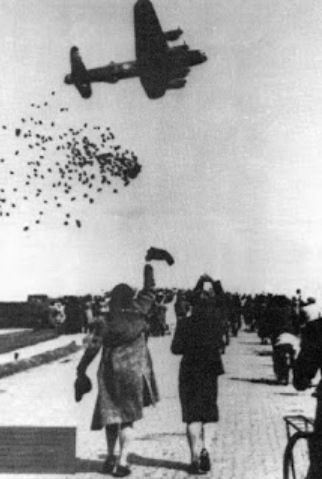
Operation Manna [Source]

Operation Chowhound [extracted by me from a Youtube video]
Photo by Jeanne Bianchine
Walcheren Moet Droog! [Walcheren Must Dry Out!]
3 Oct. 1944 . 24 Jan. 1946
[Because of the railway strike, the Nazis broke dikes in western Netherlands
in order to flood farm land and prevent the growing of crops.]
The land in western Netherlands is below sea level, which is why it was easily flooded. After repairing the dikes, I would guess that water was pumped out of the flooded section. As ground water came to the surface and evaporated, salt would be left behind. Over the years, rain would dilute the salt and carry it underground to the lowest section of land, probably near the dikes. Too much salt in the soil would prevent most crops from being grown there, but as the amount of salt was reduced over the years, more and more different crops could grow on that soil.
The following article describes which crops could grow first, and then gradually what other crops would survive as the salt in the soil was reduced.
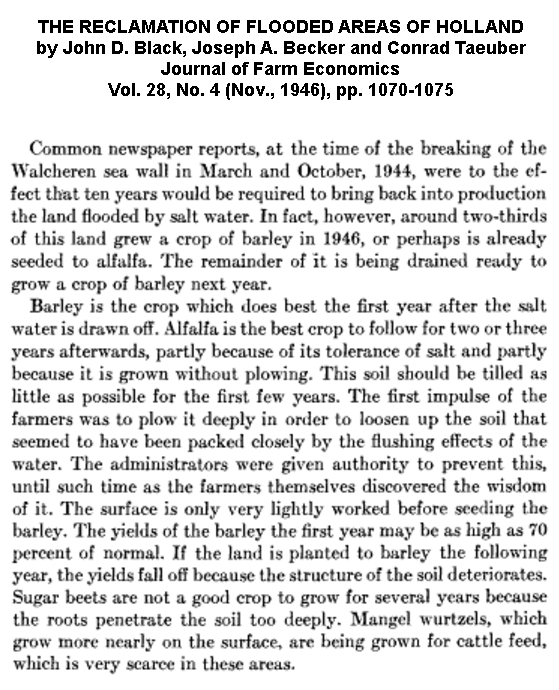
Photo by Jeanne Bianchine
5 May . Nederland Zal Herrijzen . 1945 [the Netherlands will rise.]
The previous five tiles were part of a World War II commemerative series. Two additional Delft tiles are in the collection of First Church.

Photo by Jeanne Bianchine
Birds-eye view of the city of Delft, the Netherlands
The church on the right is the Oude Kerk (Old
Church). The one in the middle is the Nieuwe Kerk (New Church). At
the left is the Rotterdam Gate.
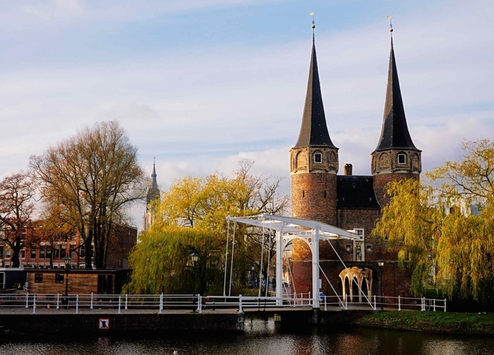 [Source]
[Source]
Rotterdam Gate, Delft, showing New Church in background
 [Source]
[Source]
The New Church, Delft
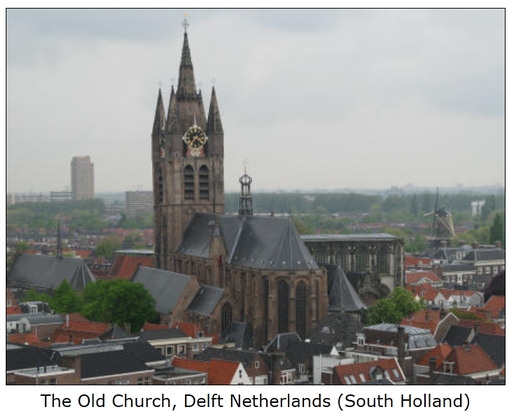 [Source]
[Source]
This view also shows the Dutch windmill seen on the tile.
The last tile shows the Oude Kerk (Old Church) in Delft.
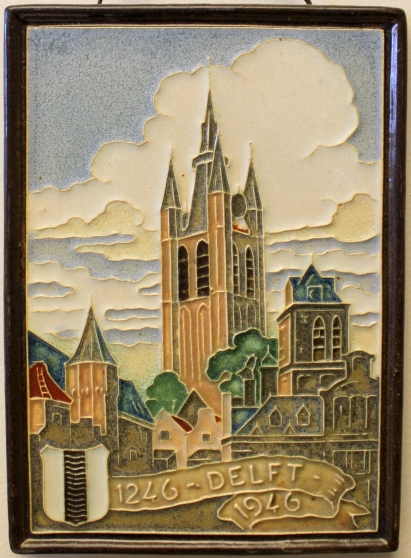
Photo by Jeanne Bianchine
Delft, 1246-1946
___________________________________________________

Visitors since 21
Sep 2016